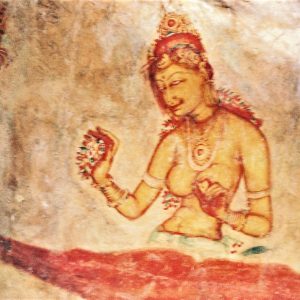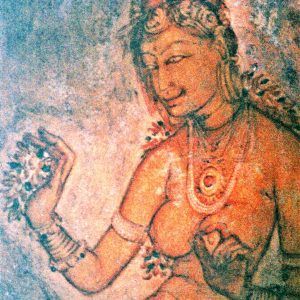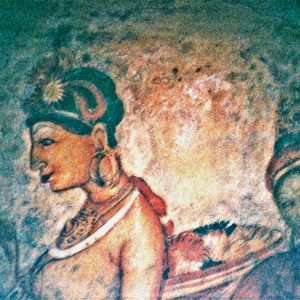Frescoes of Sigiriya, Sri Lanka -(5)
Sigiriya in Sri Lanka a UNESCO listed World Heritage Centre , is an ancient rock fortress near the town of Dambulla in Sri Lanka. The name refers to a site of historical and archaeological significance that is dominated by a massive column of rock nearly 200 metres (660 ft) high.
According to the ancient Sri Lankan chronicles the site was selected by King Kashyapa (477 – 495 CE) for his new capital. He built his palace on the top of this rock and decorated its sides with beautiful frescoes. On a small plateau about halfway up the side of this rock he built a gateway in the form of an enormous lion. The name of this place is derived from this structure — Sīnhāgiri, the Lion Rock
The fresco paintings at Sigiriya bear a closer resemblance to Buddhist paintings in the Ajanta caves in Central India than to the Anuradhapura paintings of Sri Lanka. Chronicles record that fresco paintings once covered most of the western face of the rock, an area 140 metres long and 40 metres high and up to 500 damsels featured in these paintings.
Ancient chronicles describe the beautiful frescoes as showing women ‘with high foreheads shaping their oval faces with enticing doe eyes, a rosy blush of their cheeks and lips like those of a lotus bud. These lovely maidens wear blouses of gossamer veil, the texture of which is silken cobwebs woven in the wind, seven layers of this diaphanous material is like evening dew on the grass and similar to running water’.
The Gardens of the Sigiriya city are one of the most important aspects of the site, as it is among the oldest landscaped gardens in the world. The gardens are divided into three distinct but linked forms: water gardens, cave and boulder gardens, and terraced gardens.
The capital and the royal palace was abandoned after the king’s death. It was used as a Buddhist monastery until the 14th century.
The actual site of Sigiriya has been inhabited since prehistoric times with evidence of human habitation from nearly five thousand years ago There is clear evidence that the many rock shelters and caves in the vicinity were occupied by Buddhist ascetics from as early as the 3rd century BCE.
Prints : Available as Giclee print on finest quality paper or canvas. International shipment
Sizes available: 8 x 12″(203 x 305 mm); 12 x 16″(305 x 410mm); 18 x 24″(457 x 610 mm); 24 x 32″ (610 x 813mm)
For list of prices, details of paper or canvas and pigments used, please get in touch via contact form



